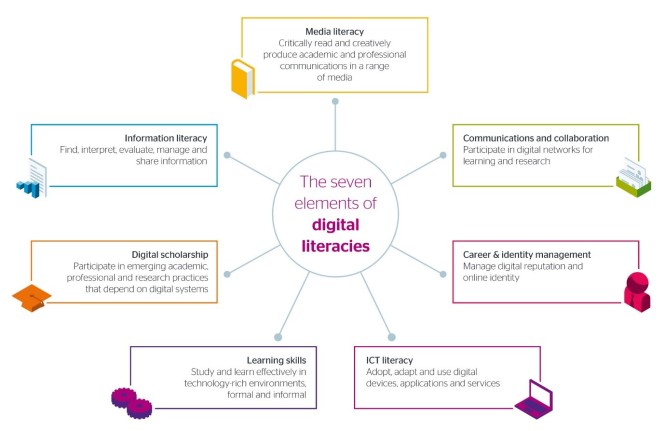Dear blog and readers,
This blog is dedicated to reflections on the ONL201 course. I acknowledge the fact that you may be human readers or robots using automatic content analysis, you are welcome both! However, as the author I am just a human being and therefore probably also make mistakes. Please, feel free to comment, correct or discuss anything you find worth it.
I have enjoyed participating the group collaboration in PBL group 11 and discussing the first topic. I have learnt many things that I expected, as well as things I did not even expect to learn. As the title of the first topic says, digital literacies and identity were the key learnings concerning the subject matters. I will reflect those in this blog post.
Who am I in the digital age and how have I become what I am? Well, I am already an old man and started the journey with digital technologies even before the dawn of digitalization in the society at large. As a young man I studied computer science and designed software and digital communication systems starting in the early 1980’s. I was also interested in education, and as early as in the middle of the 1980’s I tried teaching microprocessor technology and later on digital image processing at the technical university. However, business and Nokia caught my interest in 1990’s for the next 20 years.
Finally, in the 2010’s, I got the vocational teacher qualification and started teaching international business and management at Tampere University of Applied Sciences. I did not have background in “normal” classroom teaching, but I knew how to use Web 2.0 technologies. Therefore, I took a different approach to teaching from the very beginning and compensated my possibly poor classroom teaching skills with technology. I am still on this road with ever more increasing use of technology. I am also “digimentoring” other teachers on how to use modern technology in teaching.
In their article, David White and Alison Le Cornu (2011) propose a new metaphor for digital literacy along the continuum of visitors and residents. Furthermore, they criticize the earlier metaphor of digital natives and digital immigrants. According to White and Le Cornu, the residents see Web as a place and they consider belonging to the online communities to spend time with the others in social online networks. On the other hand, the visitors just see the Web as a set of online tools to achieve their goals. On his video Prof White (N.D.) introduces another dimension, which a continuum on an axis of personal and institutional use. This is to make disctinction between different use scenarios of the Web.
Because of the way I behave in educational online communities, I would identify myself as being a resident in institutional use of technologies, e.g. learning management systems, O365, and institutional use of web 2.0 applications. In the personal use of Web, I think I am resident only with communication related technologies, like email and whatsup. On the other hand, I consider myself as a visitor with some rarely used institutional software, and maybe with Twitter and the use of video in teaching, which I am currently starting to work on more actively. On the personal side I am a visitor to some popular platforms, like Facebook.
According to Jisc infoNet (N.D.), digital literacies are those capabilities which fit an individual for living, learning and working in a digital society. Digital literacy is not just about functional ICT skills, but a set of digital behaviours, practices and identities, as described in Figure 1. Digital literacy does not mean a static set of skills, but it is changing over time and contexts.

Figure 1: The seven elements of digital literacies (Jisc infoNet)
Reflecting on the seven elements of digital literacies, I think there are a lot of issues to improve. Maybe I am quite OK with ICT literacy, but e.g. career and identity management I have not done much at conscious level. Communication and collaboration is so much at the core of my job that it should be at decent level. However, communication is always challenging and it “normally fails except by accident”. Media literacy, as well as information literacy, are also at the core of the teacher’s job and should be at a reasonable level. I have not had much opportunities to participate in digital scholarship, but I would be interested to do so. Finally, learning skills are needed in this job, too. Learning is different at this age, but I would not say it is worse.
Even at this age I want to develop as an online teacher, and I think the ONL course will be important for my development. I have done some sort of online teaching for quite some time. However, I consider it important to get more experiences as a student in order to understand my students better and develop more empathy towards them. Furthermore, I think I will learn useful things about digital literacy and online pedagogy in general. So far, the experience of this course has been positive. The course is well thought of and organized with a functional pedagogical approach to collaborative learning. I have enjoyed the PBL group discussions with all group members, including those who unfortunately have decided to quit the course. I think there is a lot of expertise in our group and I have learnt from other members through discussions. However, maybe the most striking learning so far has been how difficult it has been to find time to do all the reading and writing tasks in the middle of coronavirus state of emergency and countless Zoom meetings.
Matti
References
Jisc infoNet (N.D.) Developing Digital Literacies. http://www.jiscinfonet.ac.uk/infokits/digital-literacies/
White D. and Le Cornu A. (2011) Visitors and Residents: A new typology for online engagement. First Monday, Volume 16, Number 9 – 5 September 2011 https://firstmonday.org/ojs/index.php/fm/article/download/3171/3049
White D. (N.D.) Visitors and Residents (video) https://www.youtube.com/watch?v=sPOG3iThmRI&feature=youtu.be